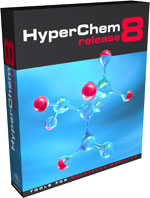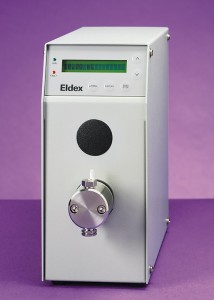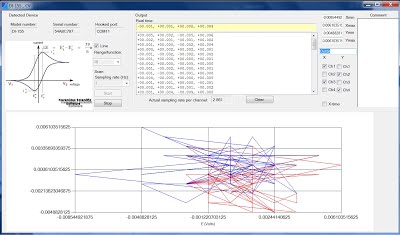
HyperChem Professional 8.0
HyperChem is a sophisticated molecular modeling environment that is known for its quality, flexibility, and ease of use. Uniting 3D visualization and animation with quantum chemical calculations, molecular mechanics, and dynamics, HyperChem puts more molecular modeling tools at your fingertips than any other Windows program.
Our newest version, HyperChem Release 8.0, is a full 32-bit application, developed for the Windows XP, Vista and Windows 7 operating systems. HyperChem Release 8.0 incorporates even more powerful computational chemistry tools than ever before, as well as supporting multiple third-party applications. Its drawing and rendering capabilities and ease of use are standards for the industry.
Structure Input and Manipulation
Building molecules with HyperChem is simple: just choose an element from the periodic table, and click and drag with the mouse to sketch a structure. Mouse control of rotation around bonds, stereochemistry, and "rubber banding" of bonds makes changing structures easy. Extensive selection, highlighting, and display capabilities make it easy to focus on areas of interest in complex molecules.
- Select, rotate, translate, and resize structures with convenient mouse controlled tools. Modify settings to control operation of tools.
- Convert rough sketches into 3D structures with HyperChem's model builder.
- Replace any selected Hydrogen with a variety of substituents including your own custom substituent.
- Apply builder constraints easily: specify bond lengths, bond angles, torsion angles, or the bonding geometry about a selected atom.
- Specify atom type, atom charge, formal charge and atomic mass.
- Build clusters and complex molecular assemblies; move individual atoms and molecules as easily as you move groups.
- Build peptides and nucleic acids from amino acid and nucleotide residue libraries.
- Mutate residues and build large molecules incrementally (make changes at any point).
- Add a periodic box of pre-equilibrated water molecules for aqueous salvation studies. Periodic boundary conditions can be used with other solvent systems, or without solvents.
- Import structures from standard file formats: Brookhaven PDB, ChemDraw CHM, MOPAC Z-matrix, MDL MOL and ISIS Sketch, and Tripos MOL2 files.
Molecular Display
- Display structures using ball and stick, fused CPK spheres, sticks, ball and cylinder, or tubes
- Add van der Waals dots to any rendering.
- Use any rendering on any atom in the same molecule.
- Specify stick or cylinder width, and the radii of spheres.
- Stereo and perspective viewing are available as well as a quality setting.
- Display a Ray Traced image of the molecules in the workspace.
- Select and name sets of atoms for custom display or monitoring of properties.
- Set and display custom labels for atoms.
- Display bond labels showing the current bond length or the currently computed quantum mechanical bond order.
- Display protein backbones using ribbons, beta sheets, random coils, cylinders, etc. with optional display of side chains.
- Highlight potential hydrogen bond interactions.
- Display dipole moment vectors and gradient vectors.
Computational Chemistry
Use HyperChem to explore quantum or classical model potential energy surfaces with single point, geometry optimization, or transition state search calculations. Include the effects of thermal motion with molecular dynamics, Langevin dynamics or Metropolis Monte Carlo simulations. User defined structural restraints may be added.
Types of Calculations
- Single point calculations determine the molecular energy and properties for a given fixed geometry.
- Geometry optimization calculations employ energy minimization algorithms to locate stable structures. Five minimization algorithms are provided.
- Vibrational frequency calculations find the normal vibrational modes of an optimized structure. The vibrational spectrum can be displayed and the vibrational motions associated with specific transitions can be animated.
- Transition state searching locates the metastable structures corresponding to transition states using either Eigenvector Following or Synchronous Transit methods. Molecular properties are then calculated.
- Molecular dynamics simulations compute classical trajectories for molecular systems. Quantum forces can be used to model reactive collisions. Heating, equilibration, and cooling periods can be employed for simulated annealing and for studies of other temperature dependent processes. Both constant energy and constant temperature simulations are available.
- Langevin dynamics simulations add frictional and stochastic forces to conventional molecular dynamics to model solvent collisional effects without inclusion of explicit solvent molecules.
- Metropolis Monte Carlo simulations sample configurations from a statistical ensemble at a given temperature and are useful for exploring the possible configurations of a system as well as for computing temperature dependent equilibrium averages.
- Excited states via singly-excited configuration interaction (CI).
Computational Methods
Density Functional Theory (DFT)
- Choose from a large variety of exchange and correlation functionals.
- Choose from a variety of integration grids
- All the options of Ab Initio calculations and basis functions (see below).
Ab Initio Quantum Mechanics
- Choose from many commonly used basis sets (STO-1G to D95**) including the standard STO-3G, 3-21G, 6-31G*, and 6-31G** basis sets
- Extra basis functions ( s, p, d, sp, spd ) can be added to individual atoms or to groups of atoms.
- Users can also define their own basis sets or modify existing basis sets easily using HyperChem's documented basis set file format.
Semi-empirical Quantum Mechanics
- HyperChem offers eleven semi-empirical molecular orbital methods, with options for organic and main-group compounds, for transition metal complexes, and for spectral simulation.
- Choose from Extended Huckel, CNDO, INDO, MINDO/3, MNDO, MNDO/d, AM1, RM1, PM3 (including transition metals), ZINDO/1 and ZINDO/S.
Molecular Mechanics
- Four force fields provide computationally convenient methods for exploring the stability and dynamics of molecular systems.
- Added flexibility of user defined atom types and parameters.
- Choose from MM , a general purpose force field, and three specialized biomolecule force fields: Amber, BIO , and OPLS.
Mixed Mode Calculations
- HyperChem allows you to perform quantum calculations on part of a molecular system, such as the solute, while treating the rest of the system classically. This boundary technique is available for all the quantum methods, with some limits for ab initio calculations.
Customize and Extend HyperChem with the Chemist's Developer Kit
- Streamline HyperChem's menus. Add new graphical and computational features; create custom menus for specific applications.
- Interface to Visual Basic, C, C and FORTRAN programs. Add dialog boxes as well as menu items. For example, you could use HyperChem for visualization of structures and results from non-graphical quantum chemistry programs.
- Link HyperChem procedures to other Windows programs such as MS Word and Excel; direct selected results to these applications for convenient analysis and reporting.
Results with HyperChem
Display
Rendering choices: Stick, Ball-and-stick, fused CPK spheres, Ball and Cylinder, Tubes with optional dot surfaces.
New Force Fields
HyperChem added significant new capability to the AMBER method of molecular mechanics by including up-to-date modifications of this force field. AMBER code supports 5 parameter sets with their associated functional forms:
- Amber 2
- Amber 3
- Amber for saccharides
- Amber 94
- Amber 96
- Amber 99
Default Parameter Scheme for MM+, AMBER, Charmm, and OPLS
Any molecular mechanics computation can continue computing with default parameters, when explicit parameters are missing from the relevant parameter file. The normal MM2, AMBER, Charmm and OPLS parameter scheme fails when explicit parameters associated with "atom types" are not available. with default parameters, no calculation fails for lack of parameters.
ESR Spectra
Calculated values of Hyperfine Coupling constants are also available, for characterizing the ESR spectra of open shell systems.
Electric Polarizabilities
Computation of polarizability tensors is available.
Plots of Potential Energy
You can select one or two structural features (bond length, torsion angle etc.) and request a plot of the potential energy as a function of either a single structural feature (2D plot) or two structural features (3D plot).
Protein Design
You can cut and paste any amino acid sequence. That is, a piece can be cut out, a piece inserted, or a sequence of one length replaced by a new sequence of a different length. Annealing operations are, of course, required for the rest of the protein to adapt to these modifications.
Electric Fields
It is possible to superimpose an applied electric field on any calculation. For example, a charged system will now drift in the workspace during a molecular dynamics run if an external electric field has been applied. Studying molecular behavior in an electric field is now possible.
Annotations
While it has always been possible to copy the rendering of molecules in HyperChem into a file or onto the clipboard and then transfer the rendering into a drawing or painting program to prepare overhead transparencies or other presentation material, directly creating such material without leaving HyperChem is now possible.
An annotation in HyperChem is a length of text that can be placed anywhere in the workspace. Because the text can have attributes such as a font, a color, and a size, it is possible to create annotations such as arrows, lines, circles, rectangles and any number of other drawing primitives. Annotating the molecules that are being modeled in HyperChem allows you to print the workspace and more easily describe to others the results of your modeling.
HyperChem contains a number of features associated with creating and manipulating these annotations. Because they exist in a plane or layer that is independent of the molecular or modeling plane, they augment rather than collide with the modeling of earlier versions of HyperChem. At the same time by being able to show or print both planes at the same time, a rich set of annotation options is possible.
While that is not the primary intent, HyperChem could now be used to prepare illustrations independent of chemistry and molecular modeling.
Charge and Multiplicity are Saved
The total charge and spin multiplicity are now stored in the HIN file and are restored when a molecular HIN file is read. Earlier, these had to be set interactively for any new molecule in the workspace.
Drawing Constraints
It is possible to constrain your drawing of 2D molecules so that the the resultant drawn molecule has uniform bond lengths and angles and resembles a standard 2D molecular representation as might be seen in textbooks. These constraints have no effect on the subsequent 2D to 3D model building.
Graphical Display of Gradients
It is possible to visualize the gradient (force) on any atom as a vector. Any set of atoms can display these vectors.
Bond Labels
A set of dynamically updated labels are available for bonds as well as atoms and residues. These bond labels can be one of:
- Bond length
- Bond order - as calculated quantum mechanically
Enhanced Selection Capability
HyperChem operations depend to a great extent on one’s ability to select a subset of atoms. For example, it is possible to select atoms based on the range of various computed quantities such as their atomic charge or atomic gradient. Thus, for example, one can now select all atoms with a charge between -0.1 and 0.1.
The atom selection options are organized as either a selection based on a "string" property of an atom, such as the atom type (e.g. CH), or a "number" property such as the atom charge described above.
Whether you use HyperChem's many internal features or build a live link with your other chemistry programs, the benefit of working with HyperChem Release 7 is that you are free to focus on the things that you do best. HyperChem does the rest.
What Was New in HyperChem 7.0 and 7.5
Density Functional Package
Density Functional Theory (DFT) has been added as a basic computational engine to complement Molecular Mechanics, Semi-Empirical Quantum Mechanics and Ab Initio Quantum Mechanics. This new computational method comes with full capabilities including first and second derivatives so that all the capabilities of other earlier engines are also available with DFT. These include geometry optimization, infrared and optical spectra, molecular dynamics, Monte Carlo, etc.
A full complement of exchange and correlation functions is available, including eight exchange functionals and eight correlation functionals that can be combined in any fashion. Also included are four combinations or hybrid functions, such as the popular B3-LYP or Becke-97 methods. A choice of various integration grids, controlling the method’s accuracy, is available to the user.
Charmm Protein Simulations
The Bio force field in HyperChem represents a version of the Chemistry at Harvard using Molecular Mechanics (Charmm) force field. Release 7.5 of HyperChem updated this force field with new functional terms and new parameters to represent the latest science from the Charmm community.
The new parameter sets for Charmm-19 represent new parameters for the bio force field of earlier versions of HyperChem, but parameter sets
Typed Neglect of Differential Overlap (TNDO)
The Typed Neglect of Differential Overlap method is a new semi-empirical method that merges ideas from molecular mechanics and semi-empirical quantum mechanics. It is designed as a generic semi-empirical method capable of high accuracy when combined with the appropriate parameters. It uses the molecular mechanics idea of atom “typing” to describe the chemical environment of an atom in a molecule with different types being given different parameters. This is the key idea that gives molecular mechanics its validity and accuracy in the absence of any quantum mechanical capability. TNDO combines atom typing a basic quantum mechanical method and allows a rapid semi-empirical method to offer reliable results. The deficiency is the need to develop parameter sets for different types (different classes of molecules) as in molecular mechanics.
HyperChem 7.5 included a first step in this parameter generation but considerable research effort on the part of Hypercube, Inc., HyperChem users, and the general research community is needed to have parameter sets that cover a wide range of chemical situations. Hypercube’s web site will collect these parameter sets.
Molecules in Magnetic Fields
It is now possible to explore the structure and reactivity of molecular systems in a uniform magnetic field. HyperChem 6 added an optional external electric field to the workspace and HyperChem 7.5 added an optional external magnetic field. The effect of magnetic fields is relatively unknown but this feature allows interactive exploration of how magnetic fields affect chemical behavior.
Two terms in the Hamiltonian are included. The first is the interaction of the magnetic field with the orbital angular momentum of electrons and the second is the Zeeman interaction of the magnetic field with the electrons’ spin. This later term is only present with open-shell systems or calculations that use the Unrestricted Hartree-Fock calculations.
Optimization of the Geometry of Excited States
A new optimization method, Conjugate Directions, has been added. This method allows geometry optimization using only energies without the necessity of computing gradients (first derivatives). This opens up the possibility of optimizing structures for a number of new situations. In particular, any state of a Configuration Interaction calculation can be optimized. These include excited states for the first time.
Optimization of MP2 Correlated Geometries
A relatively accurate and relatively simple way of including electron correlation in ab initio calculations is Moller-Plesset second-order perturbation theory (MP2). Previously, HyperChem users could calculate MP2 energies only but now, using the Conjugate Directions optimizer mentioned above, they can calculate the optimized geometry of a structure using MP2 theory.
New Rendering of Aromatic Rings
While HyperChem is fundamentally a molecular modeling program, not a drawing program, it is convenient to have available the ability to easily create annotations of molecular structures and drawings that one can use in presentations. A principal deficiency in this regard has been the lack of a “pretty picture” of aromatic rings since HyperChem represents these with dotted lines, as is convenient for most situations where one is fundamentally interested in modeling not drawing. With HyperChem 7.5, it was made possible to represent aromatic rings as a more conventional ring with a circle in the middle of it, rather than a ring with dotted bonds.
Drawing Program
In the evolution of adding convenient drawing capabilities, as just mentioned, HyperChem 6 added the concept of annotations where text (essentially) could be add to the workspace to annotate chemical structures. These “text” annotations could include many symbols (such as arrows) using various fonts. With HyperChem 7.5 this drawing capability was extended to lines, ellipses (circles), and rectangles (squares). These elements can be colored, filled or unfilled, dotted, etc.
They are included in the latest HIN file standard so that HyperChem can be used as a simple drawing program.
Interactive Examination and Manipulation of Parameters
Molecular mechanics and semi-empirical methods use a large variety of parameters. In particular, the new TNDO method lends itself to a variety of parameter sets for a variety of different chemical computations. It has always been possible to edit the text-based parameter files and re-compile them. With HyperChem 7.5, it was made possible to see parameters on-screen associated with selected atoms, bonds, torsions, etc. These can then be immediately edited if desired. In addition, it is possible, interactively, to copy whole parameter sets making it feasible to interactively explore different parameters sets in an easy fashion.
Enhanced Polymer Builder
The polymer builder has been enhanced to create branched polymers as well as linear polymers. As TAIL is attached to HEAD, it is possible to specify random attachment to either the new HEAD or an old HEAD, creating a branch in the polymer. In addition to explicitly specifying torsion angles for the HEAD to TAIL join, it is now possible to specify torsion angles for the internal backbone of the monomer; specifically, one can have these monomer backbone angles chosen randomly or as originally specified in describing the monomer.
New Basis Sets
In conjunction with the new DFT capability of HyperChem 7.5, a large number of new basis sets have been added to the sets already included with HyperChem. These basis sets are available for either the ab initio module or the DFT module.
New User Colors
When HyperChem was developed back in the 1980s for the first version of Windows, it was restricted to a total of 8 standard colors. Since many shades of these 8 are available for shaded models of molecules and orbitals, it has not been a debilitating limitation. However, it does not allow pastels and specific colors that a a particular user might desire. With Release 7.5 the limitation to 8 colors was relaxed to essentially permit you to use any of the 16 million (24 bit) colors available with most graphics cards.
Rather than forcing a user to continually decide on these 24 bits, Release 7.5 introduced the concept of "User Colors" that you can set to any of the 16 million choices and then reuse easily. This is done by adding to the standard 8 Windows colors, 4 user-definable colors referred to as user1, user2, user3, and user4. HyperChem 7.5 provided an easy way for you to define and retain, and remember these colors.
Different Rendering for Different Atoms
While Hypercube, Inc.’s version of HyperChem for Unix (SGI) allowed this, until now the Windows version of HyperChem required you to use the same rendering for every atom in the system. With Release 7.5, you could now choose to mix renderings and any of the various atom renderings can be used with any atom. A new tube rendering is now available so that any atom in the system can now be rendered as:
- Sticks
- Balls and Sticks
- Balls and Cylinders
- Overlapping CPK Spheres
- Tubes
In addition, any atom can have a dot surface added to its rendering. The radii of all balls, spheres, cylinders, and tubes can be varied.
Protein Capabilities
Release 7.5 added significant new capability for dealing with peptides and proteins, particularly as related to Protein Data Bank (PDB) files. The new features are:
- Peptide builder knows further secondary structure, such as 3-10 helix, for example.
- Protein secondary structure is part of each residues definition. Each residue can be helix, sheet, turn or random coil.
- Protein secondary structure is automatically extracted from PDB files and automatically retained in corresponding HIN files.
- You can make a selection based upon protein secondary structure.
- Secondary structures, such as helices and sheets, can be rendered in a variety of new ways. There are now two main rendering motifs - rendering of atoms and rendering of secondary structures.
- Selection can be used to arbitrarily color secondary structure renderings.
Secondary Structure Renderings
HyperChem has always contained a relative primitive ribbon rendering of proteins. That is, the earlier rendering consisted of parallel lines along the backbone. With Release 7.5 and the introduction of OpenGL into HyperChem, a number of other more sophisticated solid ribbon-like renderings were made available. These consist of:
- Ribbon lines.
- Thin solid ribbons.
- Thick solid ribbons.
- Cylinders - normally representing the position of head and tail of helices.
- A tubular coil rendering - normally representing random coil secondary structures.
The properties of these protein secondary structure renderings, such as thickness (or radius) can be manipulated to suite your personal taste. They can be colored in arbitrary ways. A default secondary structure rendering is based of the actual secondary structure (such as cylinders for helices). However, you can customize the secondary structure rendering (for example, using a tubular coil rendering for helices rather than a cylinder).






